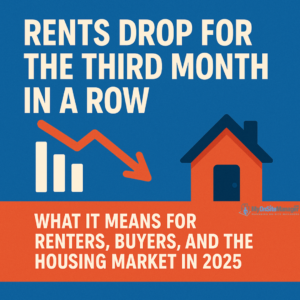As housing affordability continues to dominate national headlines, there’s finally a silver lining for American renters. Realtor.com’s July 2025 Rental Report reveals that median asking rents declined for the third month in a row, giving renters some breathing room in a market that has been unforgiving for years.
And while rent relief is a welcome change, the deeper insights from the report reveal even more about the complex state of the U.S. housing market—especially why, in nearly every major city, renting remains significantly more affordable than buying.
Let’s unpack what this report means for tenants, aspiring homeowners, and the real estate industry.
Key Highlights from the Report
-
National rents declined again in July, continuing a three-month trend of decreases.
-
In all of the top 50 metro areas, it is cheaper to rent than to buy a starter home.
-
Buying costs are now 60% higher than renting on average—an increase from 52% just a year ago.
-
Two-bedroom rental units cost 27% more than in June 2019, but prices are gradually cooling.
-
New York City saw a 4.7% rent increase—the highest among metros—while Western markets saw the biggest declines.
Renting vs. Buying: The Growing Cost Divide
Homeownership has long been the American dream, but in today’s market, it’s becoming a luxury that fewer can afford.
As of July 2025:
-
The monthly cost to buy a typical starter home is about $1,027 more than renting the same space.
-
That gap is even wider in cities like Los Angeles, San Diego, and Seattle—where high mortgage rates and property prices collide.
Rising interest rates, which have consistently hovered above 7%, combined with still-elevated home prices, have made buying inaccessible for many Americans. This cost disparity is forcing potential buyers to delay their plans and remain in the rental market longer than they may have hoped.
Regional Breakdown: Where Are Rents Falling or Rising?
The report shows that location still plays a massive role in rental pricing.
Western U.S.: Rent Relief in Full Swing
-
Cities like Las Vegas, Phoenix, and Sacramento have seen notable year-over-year declines.
-
The West saw the largest regional decline in median rents, down 3.8% year-over-year.
-
Increased multifamily supply and slower migration patterns are cooling the market.
Midwest and South: Stable to Slight Growth
-
The Midwest remains the most affordable rental region overall.
-
Cities like Cincinnati and St. Louis continue to offer budget-friendly rents with minimal fluctuation.
-
In the South, metros like Austin are seeing slight dips due to a surge in apartment supply, while others like Miami remain expensive due to limited inventory.
Northeast: Still Climbing
-
The Northeast remains the priciest region for renters overall.
-
New York City led the nation with a 4.7% rent hike compared to July 2024.
-
Other major metros like Boston and Washington D.C. also saw moderate increases, driven by limited housing supply and strong job markets.
Rents Are Dropping—But Still Elevated from Pre-Pandemic Levels
While the declines are encouraging, rents are still much higher than they were before the pandemic:
-
A two-bedroom unit costs 27% more than it did in June 2019.
-
One-bedrooms are up 22% during the same period.
This suggests that while renters may finally be seeing relief, the long-term trend still favors landlords—especially in markets where housing production has not kept pace with demand.
What This Means for You: Renters, Buyers, and Investors
For Renters:
Now might be a great time to shop around or negotiate your lease. As inventory grows and demand softens in certain cities, renters have more power to secure better deals. Stay informed about local market trends and don’t hesitate to explore different neighborhoods.
For Aspiring Buyers:
Hold tight. With ownership costs far outpacing rental prices, it may be wise to delay buying until mortgage rates stabilize or housing prices soften. Use this time to build credit, save for a down payment, and monitor the market closely.
For Property Managers & Investors:
This shifting landscape calls for strategic thinking. In cooling markets, offering move-in specials or adjusting pricing could improve occupancy rates. Meanwhile, areas like the Northeast may continue to see solid returns despite national softening trends.
Final Thoughts: The Rental Market Is Rebalancing—Slowly but Surely
The U.S. rental market is clearly going through a period of normalization. After years of aggressive price growth and affordability crises, rents are finally stabilizing in many regions, giving hope to millions of Americans.
However, the affordability gap between renting and buying continues to widen, keeping many renters sidelined from homeownership for the foreseeable future.
If you’re a renter, this is your window to find better deals. And if you’re in real estate, now’s the time to pay close attention to changing trends—because 2025 might just mark the beginning of a new rental era.
Read the full report here: Realtor.com® July Rental Report – Yahoo Finance

